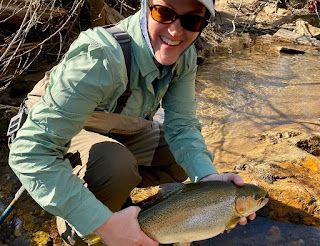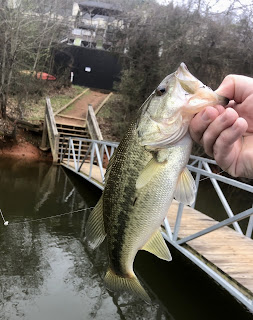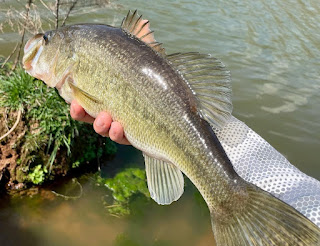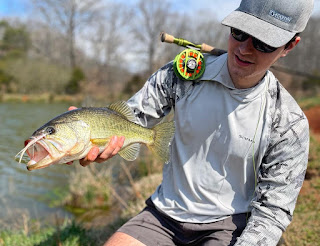Weekend diehards should come with both winter and high water games. Water temps and flows will dictate tippet size, shot size and number, and fly patterns. Look down on wet pavement, ID the storm hatch, and match it with your squirmies and San Juans.
If you hang near home this weekend, fine-tune your fly vest. Look over those spring hatch chart websites that I gave you last week and ensure your boxes are stocked. Be ready to catch the real bugs, too. Go to Home Depot and buy a paint strainer to slip over your landing net. Swat some adult bugs and seine below submerged boulders and leaf packs that you’ve turned to sample the nymphs. You don’t have to know Latin names of bugs nor fly pattern names. Just match your fake’s size, shade(color), position in/above water column, and behavior to the real bugs you see. Then you’ll be in business.
The lakes are waking up. We have several decent reports in our long version of this. One extra tip: fish the funnels! Lakes are big and intimidating, but spring spawning runs funnel favorite predators to lake headwaters and incoming rivers. The next month is prime. Walleye are winding down, but whites and hybrids are firing up. Striper romance will follow around the last week of March and last three weeks. Don’t miss the prime intel from GAWRD. Electricity doesn’t lie. Look over biologists’ brand new annual fishing prospects and the weekly sampling results via the blog. Mine this agency intel here:
https://georgiawildlife.com/fishing/angler-resources
Aim for Blog and Prospects.
Good luck. Let’s look beyond this crummy weekend and smile at the bright horizon, when we all spring ahead to the best two months of flyfishing in this neck of the woods. Stop by either UO store or knock online if we can help your spring celebration.
Wes’ Hot Fly List:
Dries: black elk hair caddis, griffiths gnat, quill gordon, parachute adams.
Nymphs and wets: hot rib Duracell, span worm, hares ear and pheasant tail nymphs and soft hackles, pats rubberlegs, small peach eggs.
Streamers: mini gulp snack, hot cone woolly bugger, Kreelex, and mini finesse changer and gray/white clouser for the lakes.
Headwaters:
Landon: “We went shooting on the national forest and stopped for a little break on Notellum Creek. We did pretty good on small wild fish for short time we fished. A soft hackle hares ear was the fly of choice.”
RSquared: “I fished one of North Georgia's most popular wild trout streams Thursday. The Spring-like weather had the wild rainbows looking up. Caddis & orange stimulators were working for me. This coming weekend’s cold front will have the salmonids hugging the bottom again.”
DH:
We had few angler reports. Since it’s a new month, we do expect a GADNR maintenance stocking soon.
Sautee and a buddy hit Nan DH and reported: “Nantahala DH was rolling on Tuesday with an apparent water release from Nantahala Lake. Freshly stocked fish weren't responding to small naturals or egg patterns. I Caught 2 on squirmy late in afternoon. Very few bugs ( a couple March browns, a few stoneflies hatched at water level on rocks) and nothing rising. Folks planning a trip up here need to check both the USGS river gauge at Rainbow Springs and the Duke Energy Lakes web page to get an idea of DH flows before coming up.”
Private Waters:
UO Helen manager Wes said his clients did well last week swinging small, dark nymphs in the clear, warmer water. He predicts that we’ll have to dredge “legs and eggs” during the next few icy, wet days before returning to that early spring pattern next week.
UO Guide Israel: “The Hooch and Soque are both fishing great. Most fish are still on smaller nymph patterns. A few others are starting to eat bigger bugs. My clients have had good success by swinging soft hackles in the afternoon for something different. I’m also seeing a ton of midges hatching in the afternoon.”
Lanier:
Web reports show birds diving and stripers busting the surface on Lanier.
https://www.facebook.com/pages/category/Fishing-Store/CaptainMacks/posts/
It’s sporadic, so you must be in the right place at the right time. Practice your B’s: 1) burn some gas to recon a lot of water; 2) use your binoculars to spot some birds; 3) buy Henry’s book to unlock the secrets to inland stripers.
https://shoponline.unicoioutfitters.com/accessories/
HenryC:
“Fish are still hit and miss on Lanier. Hits are becoming slightly more normal than misses if you have the right weather pattern to follow. Go out and fish pre frontal vs post frontal and you can find fish that have obviously started their pre spawn phase and are fattening up to make the long swim up the river. They are eating both small shad and micro shad 1"-3" in length. Keep the somethin else's as well as Clouser's and game changers handy. If you're blind casting then a coyote is a good choice. Spring is here and so are the linesides.”
Landon: “ I threw the slip bobber rig at Lanier, prefrontal on Tuesday before the rain came in. Had 5 bass in an hour and saw some stripers and loons working back there, too.”
UO staffer Joseph:
“Here are some pics of some largemouth I caught the other day. With the temps finally starting to rise, it’s starting to pull bass in smaller impoundments into the shallows. These fish came on a white clouser but any baitfish pattern 2-4 inches long should get the job done. One important factor I want to mention is having a intermediate fly line and trying various retrieval speeds through the day. Overall it seems a countdown method was the best bet if you aren’t able to sight fish any.”
In summary, be ready to revert to your winter game for a few days. Then, as waters warm, be on the lookout for bugs and match the hatch with your dry/dropper combos. Stop in the shop for a shot of heat and a handful of hot flies. If you’re stuck at home, go online and win yourself a summer week in Yellowstone:
Good luck online and afield!
Unicoi Outfitters: Friendly. Local. Experts.













No comments:
Post a Comment